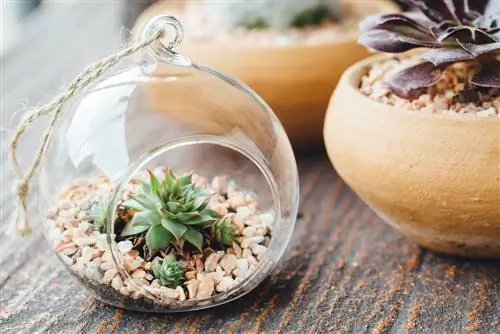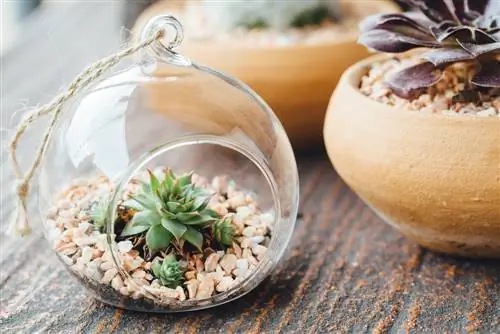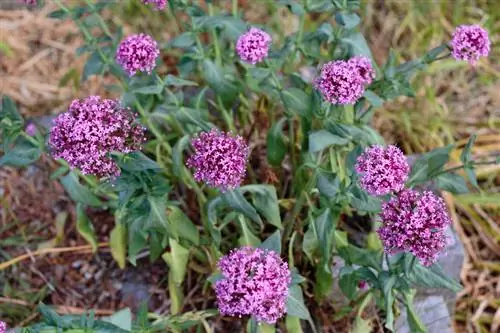- Author admin [email protected].
- Public 2023-12-16 16:46.
- Last modified 2025-06-01 06:02.
Succulents seem like creatures from another world. With their fleshy leaves and shoots, they form striking silhouettes ranging from a few centimeters to several meters high. How good that the diverse plant community pulls together when it comes to care. You can find out how to properly care for these juicy survival artists here.

How do you properly care for succulents?
Succulent care includes sparing watering when the soil is dry, conservative fertilization every 3-4 weeks (May-September), occasional cutting with a disinfected knife, cool overwintering at around 10 degrees Celsius and protection against diseases and pests through appropriate care.
Watering succulents correctly - how does it work?
Succulents mostly come from regions of the world where water is in short supply. In order to survive there, they have learned to store water inside them for bad times. The ingenious survival strategy can be recognized by the fleshy leaves, shoots, trunks and roots. Watering should be tailored to this characteristic, because the plants cannot tolerate excessive moisture. How to do it right:
- From spring to autumn, only water when the soil is noticeably dry
- Before each watering, stick your finger into the substrate to check the moisture content
- Do not water in winter or only water in small sips
Please use mostly rainwater or stale tap water, as most succulents cannot tolerate lime. To properly estimate the moisture content of majestic succulents, a thumb test is not always enough. With a simple moisture meter (€9.00 on Amazon) you will always know exactly whether there is a need for watering or not.
When and how should you fertilize succulents?
Please be just as cautious when supplying nutrients as when watering. From May to September, fertilize your succulents every 3 to 4 weeks. For this purpose, add a special cactus or succulent fertilizer to the water. In the bed, the plants gratefully accept a portion of leaf compost or horn shavings. Rake in organic fertilizer only lightly and then water with soft water. In the open field, stop applying fertilizer at the beginning of August so that hardy succulents can mature before the first frost.
Cutting succulents - is that possible?
If the mighty columnar cactus hits the ceiling or a leaf dies on the agave, you can solve the problem with a courageous cut. The vast majority of succulent species can cope with pruning without harm. Please use a sharp knife disinfected with alcohol. Dust the sap flow from a cut with charcoal ash or rock dust. Alternatively, briefly dab the interface with a cloth dipped in hot water.
How do succulents overwinter?
Succulents ideally do not spend short days and a lack of light in the winter in a well-heated living room. If the normal water and nutrient supply continues seamlessly during the cold, dark season, thin, rotting shoots can develop and break off. It's better if you overwinter the plants like this:
- From November to February, keep it bright and cool with temperatures around 10 degrees Celsius
- Water less or not at all
- Do not fertilize from October to February
Please equip your winter-hardy succulents in the bed with a rain cover. The bottleneck here is not the frosty temperatures, but the constant wetness of the Central European winter. You can either put the bucket in a frost-free, bright winter quarters or cover it with bubble wrap and a coconut mat.
What diseases are to be feared?
Fungal infections are the most common succulent killers. This is especially true if a plant is weakened as a result of neglected care. These diseases can occur:
- Focal spot disease (Gloeosporium): sunken, brown spots, hard and barky epidermis
- Fusarium wilt (Fusarium verticillioides): brown shoot tips, red-purple spore coating and wilting symptoms
- Root and stem rot (Phytophtora): softened body, rotting roots
Diseases always have an easy time on succulents when the plants are watered excessively. Nitrogen-based fertilization with conventional flower fertilizer also often causes problems. However, if the water and nutrient balance is in balance, the plants develop robust defenses against all kinds of pathogens.
Which pests target succulents?
Various pests target succulents indoors and outdoors. The beasts usually lie in wait for weakened plants and are not deterred even by the thorns on cacti. The following pests are at the top of the list:
- Spider mites: mostly in winter, speckled leaves and shoots as well as white webs in the leaf axils
- Mealybugs and scale insects: at any time of the year, small bumps on the epidermis, white, wooly coating
- Big-mouth weevil: adult beetles and their larvae in the bed eat the plants
It is usually not necessary to use chemical insecticides to combat pests. The classic soft soap solution has proven to be effective against spider mites and lice. In the early infestation stage, repeated spraying can put an end to the plague. Furthermore, ecological products based on neem and rapeseed oil put an end to insects. Black-mouthed weevils and their larvae are effectively controlled with nematodes.
Tip
Succulents can survive without soil for weeks. Creative indoor gardeners know how to use this special property for breathtaking decoration ideas. The branches of the penny tree, for example, are very suitable for creating spectacular table decorations. Or you can fill a disused terrarium with sand to artfully arrange cacti.






